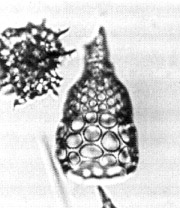 Lamprocyrtis
heteroporos (Hays)
Lamprocyrtis
heteroporos (Hays) Lamprocyrtis
heteroporos (Hays)
Lamprocyrtis
heteroporos (Hays)Lamprocyclas heteroporos Hays, 1965, p.179, pl.3, fig.1; Kling, 1971, p.1088, pl.1, fig.1
Lamprocyclas heteroporos ? Hays, 1970, p.214, pl.1, fig.3
Lamprocyrtis heteroporos (Hays), Kling, 1973, p.639, pl.5, figs.19-21, pl.15, fig.6
Shell rough, campanulate, with indistinct collar stricture but distinct lumbar stricture; relative length of three joints 2.5:5:7, although in some specimens the thorax and abdomen are nearly equal. Cephalis [three-lobed,] hemispherical, pores circular to subcircular with diameter about equal to bar width. Cephalis bears a long three-bladed apical horn, as long as, to three times as long as, cephalis. Thorax campanulate, with pores similar in size and shape to those of cephalis, arranged in irregular longitudinal rows, 5-7 pores per row; pores increase in size distally. Abdomen cylindrical to slightly conical with maximum diameter just above mouth; pores large, irregular in size and shape, separated by thick bars; abdominal pores 2-3 times the size of thoracic pores. Aperture slightly constricted, 3-5 poorly developed short terminal teeth extend downward from a thick peristomal ring (Hays, 1965).
Length of apical horn 22-60 µm, of cephalis 15-25 µm, of thorax 48-65 µm, of abdomen 55-70 µm. Maximum width of shell 88-100 µm, diameter of thoracic pores 4-9 µm, usually about 6, of abdominal pores 10-22 µm (Antarctic; Hays, 1965).
Length of apical horn 15-70 µm, of cephalis 21-35 µm, of thorax 41-82 µm, of abdomen 50-110 µm. Width of cephalis 26-44 µm, of abdomen 88-120 µm. Diameter of pores, thorax 3-12 µm, usually 6 µm, abdomen 3-50 µm, usually 24 µm (North Pacific; Hays, 1970).
L. heteroporos is easily distinguished from other members of the genus by its cylindrical abdomen and the contrast between the large pores of the abdomen and the smaller pores of the thorax (Hays, 1965).
This species is essentially absent from tropical sediments. In middle latitudes its morphotypic first appearance lies within the Sphaeropyle langii Zone and its morphotypic last appearance lies within the Eucyrtidium matuyamai Zone.
The genus Lamprocyrtis was erected by Kling (1973) to accommodate the lineage from L. heteroporos to L. nigriniae. The lineage initially includes three-segmented forms, but later forms are only two segmented. Members of the genus usually have an open, indistinctly three-lobed cephalis, which tends to be cylindrical. The cephalis bears one stout, three-bladed apical horn and commonly one or more accessory spines. Pores of the post-cephalic segment(s) usually increase in size distally, earlier species displaying a distinctive irregular row of axially to inwardly directed teeth that sometimes occupy a weakly developed peristome. Teeth occasionally occur outside the terminal row, but do not constitute a distinct second row as in Lamprocyclas Haeckel, 1881 (modified from Kling, 1973).
According to Kling (1973) L. heteroporos is the ancestor of Lamprocyrtis neoheteroporos, which in turn evolved into L. nigriniae; Lamprocyrtis(?) hannai (Campbell and Clark) is a likely ancestor of L. heteroporos. However, Caulet (1986, p.850, pl.3, figs.13-16) has described, from the lower part of the Spongaster pentas Zone, a morphotype, Lamprocyrtis daniellae, which is similar to L. nigriniae. He suggests that L. daniellae may be the ancestor of L. nigriniae and that the L. heteroporos -> L. neoheteroporos lineage may need to be revised.
Morphotypes similar to Lamprocyrtis nigriniae were found in samples from the Spongaster pentas Zone in DSDP Sites 77B, 157, 173 and 494. These forms appear to be closely related to L. hannai (Campbell and Clark) (Kling, 1973, p.638, pl.5, figs.12-14, pl.12, figs.10-14), and are below the earliest occurrence of L. neoheteroporos (Sanfilippo et al., 1985).
The individuals of this species from the North Pacific resemble in nearly all aspects the Antarctic individuals. They differ only in being on average larger than the Antarctic forms and some have a lateral oblique spine rising from the cephalis (Hays, 1970).